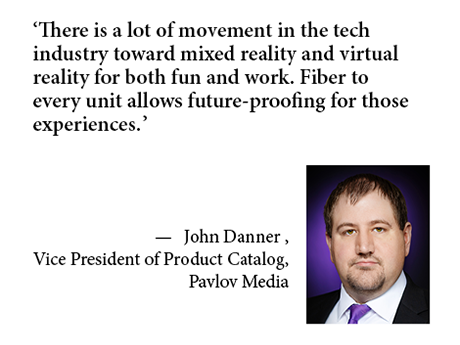Technology, like commercial real estate, becomes increasingly vulnerable to the need for replacement and updates over time. Just as multifamily landlords can update properties by periodically replacing outmoded flooring and fixtures to suit the latest occupier preferences, technology must also keep up with the latest trends. For the best renter experience, multifamily properties need Internet connectivity that will serve residents as their technological needs grow and their tolerance for frequent outages diminishes. Disruptions associated with repairs or network upgrades can threaten customer satisfaction and renewal rates.
Unfortunately for many landlords who rely on traditional telecommunications lines for their properties’ Internet, modern usage is straining older infrastructure. Booming wireless technology use is gobbling up bandwidth to connect everything from consumers’ phones and laptops to fitness monitors, smart TVs and other household appliances.
As a vice president of product catalog who has worked for over a decade at broadband service provider Pavlov Media, John Danner understands the problem of limited Internet bandwidth all too well. He is eager to see technological improvements that will replace these old systems. “The old copper infrastructure can’t meet the requirements of the next generation of wireless connectivity,” explains Danner. “With fiber-optic connections, the sky is the limit on throughput. You can have any number of frequencies of light traveling through it simultaneously.”
Pavlov Media is helping multifamily and student housing owners position their properties at the leading edge of connectivity so residents can fully enjoy current and future generations of digital experiences. The nation’s largest private provider of fiber-based Internet and video services to off-campus student housing, the Champaign, Ill.-based company’s last-mile networks are giving client properties uplink speeds that average 10 gigabytes per second (GB/s).
“In municipal markets where we own the fiber in the ground, a client may only be buying three gigabytes initially, but we build out for as much as 100 gigs in some markets,” Danner says.
Coupling fiber with other innovative features, including high-volume switches adapted from the call-center industry and wireless-access-point systems more often associated with enterprise-level installations, Pavlov Media’s networks are designed to give residents maximum connectivity amid steadily increasing transmission volume.
Future-Proof Networking
Part of Danner’s role is understanding how multifamily and student-housing residents experience the Internet, and then engineering optimal infrastructure and operations to support those experiences. He is an avowed technology buff who joined Pavlov Media in 2011 as a technical support technician, moving on to apply his formal training in network administration.
Pavlov Media encourages team members to climb career ladders within the company and was soon leveraging Danner’s abilities in the engineering department. His role had expanded to exploring new technologies, tools and systems that could improve operations.
Today, Danner helps teams throughout the company to create similarly standardized service packages that revolve around end-user expectations.
“We aren’t selling fiber and switches; we are delivering an experience for the end user,” Danner says. “Behind the scenes, we are building out our internal parts catalogs between teams to capture the hardware and scope of work that experience requires.”
For example, the excess capacity Pavlov Media builds into new network connections ensures the provider will be able to deliver a consistent experience long term. It also establishes stout network “trunks” for branching out to new customers or increasing the number of connections serving existing clients.
Pavlov Media’s approach is pushing the industry forward, as some of the firm’s competitors are beginning to implement 10 GB/s uplink speeds and some are incorporating call-center switches to manage signal traffic, following on Pavlov Media’s pioneering efforts.
What’s next for the industry? Danner’s team is working with high-end product manufacturers and their systems for multifamily applications, such as centrally managed Wi-Fi access points. He sees a need to deliver what have traditionally been enterprise or B2B experiences to end users in student housing, multifamily and single-family housing.
Recreating those experiences in a residential setting will ultimately require direct fiber connectivity, he contends.
“The future that Pavlov Media sees is one in which there is fiber to every unit of a student housing or multifamily complex. In our fiber-to-the-home services, we are looking at fiber to every room,” Danner says.
“There is a lot of movement in the tech industry toward mixed reality and virtual reality for both fun and work,” he says. “Fiber to every unit allows future-proofing for those experiences.”
— By Matt Hudgins. This article was written in conjunction with Pavlov Media, a content partner of REBusinessOnline. For more information on Pavlov Media, click here.


